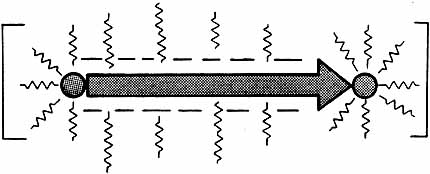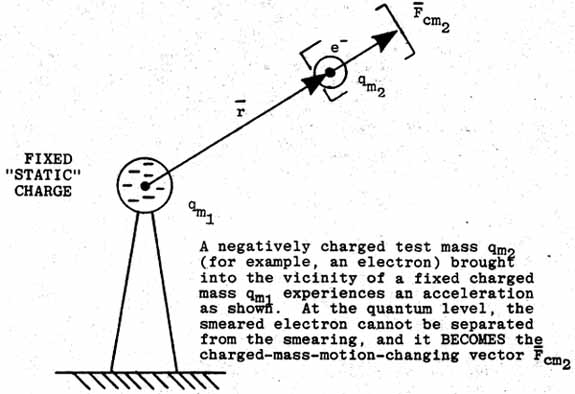

(ELECTRICIAN'S VECTOR)
Figure 4. Charged mass system vector.
|
-- CHARGED-MASS-SYSTEM VECTOR -- The third type of vector we meet is the vector mass system where the mass is charged. First, we point out a serious error in present electromagnetic (EM) theory. That is, in present theory it is implicitly assumed that
In other words, "charge" and "charged mass" are
erroneously assumed to be identically the same thing.
Figure 5. The "charge" on an electron
mass consists of Thus, actually the "charge" is the virtual (unobservable, or SPATIO-TEMPORAL) flux to and from the observable SPATIAL particle of mass. So, rigorously,
But instead,
and this is a definition and therefore an identity. This definition
alone affects all present electromagnetics theory. |

Figure 6. A test charge (charged mass) brought near a
fixed charge
(charged mass) experiences an acceleration.
|
Now note that what actually happens is that the unrestrained test charge becomes a CHARGED MASS SYSTEM VECTOR (a "smeared charged mass-motion changing"). The "test charge" BECOMES a charged mass force vector; it does not have a separate geometer's vector "appear on it." What actually happens is shown in Figure 7.
Figure 7. A charged-mass-system vector. That is, in the simplest (nonrelativistic) case, for an electron what happens is
and this is a DEFINITION. That is, considered
instantly, the electron exists as a charged-mass electrical force
CONSISTING OF/COMPRISED OF a charge flux qe canonically
coupled to a mass, with that subsystem then canonically coupled to a
spatial acceleration vector, ALL AS A SINGLE ENTITY, WITHOUT ANY
"SEAMS" BETWEEN ITS "PARTS." The
Figure 8. Repeating the "test charge" experiment. It is found that, rigorously,
where
where
In this definition,
where |